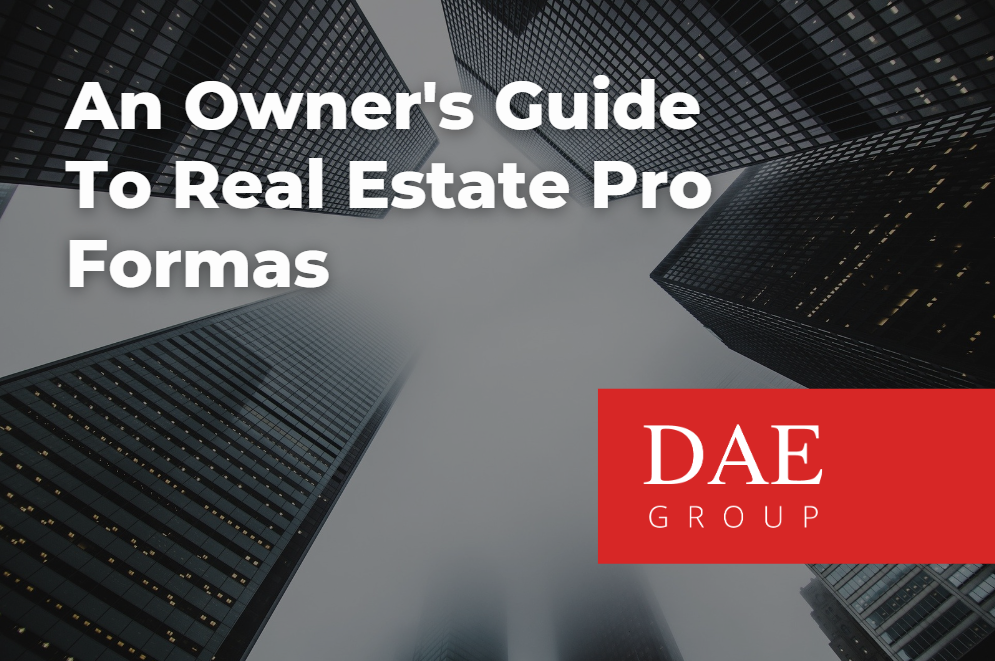A real estate “pro forma” is a look into the future for a particular piece of property.
Investors use “pro formas” as a tool to make assessments about a project’s anticipated use, its anticipated costs, its anticipated revenues and its anticipated cash flows and return on investment, They create a financial picture of a property so that investors can “see” into the future and make decisions about whether to become involved in a project and its use at a particular time.
What is a Pro Forma?
Pro forma is a Latin term meaning “for the sake of form.”
Pro formas are often created in Excel spreadsheet software and take on different “forms” depending on whether the property in question is new vs. existing and whether the intended use is for office, retail, medical, educational, governmental, industrial, residential single-family, multi-family or manufacturing.
Fundamentally, pro formas are a project’s cash flow projections. This includes all the costs, all the anticipated revenues, when the costs and revenues will be realized, and the project s anticipated positive cash flows that would be available to investors if all the assumptions are correct.
With this information investors make a decision about a project’s viability given their current situation and location in the business cycle.
What are the components of a pro forma?
The actual components of a pro forma vary from project to project and from usage to usage. However, every pro forma will have basic components such as:
- hard and soft costs for construction and land
- anticipated revenues from either sales or leasing
- anticipated timelines for realizing those revenues
- projected monthly expenses to operate and maintain the project post-construction including taxes
- ROI analysis
Another way to look at the components of a pro forma is to review the information that goes into one at various phases of the development process: Pre-development, Construction and Post Construction/Operations.
Pre-Development Phase
The Pre-Development phase includes Planning and Initiation and Feasibility.
In Planning anticipated costs include the soft costs of data collection: developmental, environmental, and governmental including the costs of studies and surveys, design, and the development of project objectives and identification of major issues.
Feasibility includes the soft costs of data analysis and recommendations such as supply, demand, growth rates, sales pricing or leasing rates, and absorption rates. With the design comes operating performance projections such as the type of project, number of units, timing of units coming online, anticipated operating revenues, construction hard costs, and anticipated operating expenses.
Another part of Feasibility is the financial analysis which includes the costs of initial project financing: Equity, Debt, Ownership, Terms, and Structures.
Construction Phase
The pro forma for the Construction Phase of the development process includes timelines and the hard and soft costs of actually constructing the project.
Hard costs are often referred to as the “brick and mortar costs.” Examples of hard costs would be raw materials, labor, and fixed equipment and interior finish. Examples of soft costs are legal fees, architectural fees, indirect labor, consultant fees, surveys, permits cost of inspections and cost of construction financing.
The pro forma for the Post Construction / Operations phase of development includes anticipated revenues from sales, leasing, retail, parking, etc. and the anticipated expenses for the operation of the project, cleaning, maintenance (both interior and exterior including seasonal adjustments), and replacement of furnishings over time.
Important items to include in the expenses are repairs, vacancy loss including the painting, cleaning and repairs needed when a tenant moves out, property management fees. And miscellaneous fees which can include legal, advertising costs and taxes.
Post-Construction Phase
The Post-Construction “operations” phase of the development process is where many pro formas can go wrong. Areas to watch out for include the revenue side of the equation — overly zealous sales or rent projections, unanticipated competition that drives the price down, changes in the economy, and pandemics.
On the expense side, there is a tendency to underestimate expenses. Marketing and advertising come in over budget, reserves for repairs and maintenance are under budget, maintenance costs go up, HVAC repairs are not under warranty, vacancy loss is higher than anticipated, property management fees are higher, taxes go up, receivables take longer to collect, etc.
Remember, fundamentally, a pro forma is a best guess at anticipated expenses and revenues. And that reality, generally, does not like to cooperate with our projections about the future. So a conservative posture is prudent in developing all of the assumptions that go into a pro forma. Make sure the grounding for your assumptions are solid – not overly optimistic, not overly conservation.
Once all the numbers are in, common financial or ROI analysis in pro formas include Gross Potential income, Capitalization, Net Operating Income, Net Cash Flow, Return on Cost, Internal Rate of Return and Discounted Cash Flow.
With ROI projections real estate investors can compare real estate projects. They use them to avoid making poor or ineffective investments. They use them to “see” in real terms, the opportunities of various real estate projects.
In Conclusion
But remember, a pro forma is only as good as the numbers and assumptions that go into one. For this reason all assumptions should be checked with experts, such as the DAE Group, to make sure the interpretations, numbers and scheduling reflect reality and not fantasy.

